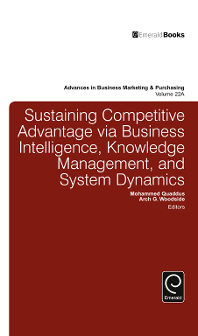Sustaining Competitive Advantage Via Business Intelligence, Knowledge Management, and System Dynamics: Volume 22A

Table of contents
(8 chapters)Abstract
The strategic management literature emphasizes the concept of business intelligence (BI) as an essential competitive tool. Yet the sustainability of the firms’ competitive advantage provided by BI capability is not well researched. To fill this gap, this study attempts to develop a model for successful BI deployment and empirically examines the association between BI deployment and sustainable competitive advantage. Taking the telecommunications industry in Malaysia as a case example, the research particularly focuses on the influencing perceptions held by telecommunications decision makers and executives on factors that impact successful BI deployment. The research further investigates the relationship between successful BI deployment and sustainable competitive advantage of the telecommunications organizations. Another important aim of this study is to determine the effect of moderating factors such as organization culture, business strategy, and use of BI tools on BI deployment and the sustainability of firm’s competitive advantage.
This research uses combination of resource-based theory and diffusion of innovation (DOI) theory to examine BI success and its relationship with firm’s sustainability. The research adopts the positivist paradigm and a two-phase sequential mixed method consisting of qualitative and quantitative approaches are employed. A tentative research model is developed first based on extensive literature review. The chapter presents a qualitative field study to fine tune the initial research model. Findings from the qualitative method are also used to develop measures and instruments for the next phase of quantitative method. The study includes a survey study with sample of business analysts and decision makers in telecommunications firms and is analyzed by partial least square-based structural equation modeling.
The findings reveal that some internal resources of the organizations such as BI governance and the perceptions of BI’s characteristics influence the successful deployment of BI. Organizations that practice good BI governance with strong moral and financial support from upper management have an opportunity to realize the dream of having successful BI initiatives in place. The scope of BI governance includes providing sufficient support and commitment in BI funding and implementation, laying out proper BI infrastructure and staffing and establishing a corporate-wide policy and procedures regarding BI. The perceptions about the characteristics of BI such as its relative advantage, complexity, compatibility, and observability are also significant in ensuring BI success. The most important results of this study indicated that with BI successfully deployed, executives would use the knowledge provided for their necessary actions in sustaining the organizations’ competitive advantage in terms of economics, social, and environmental issues.
This study contributes significantly to the existing literature that will assist future BI researchers especially in achieving sustainable competitive advantage. In particular, the model will help practitioners to consider the resources that they are likely to consider when deploying BI. Finally, the applications of this study can be extended through further adaptation in other industries and various geographic contexts.
Abstract
The objective of this study is to investigate how country risk, different political actions from the government and bureaucratic behavior influence the activities in industry supply chains (SCs) in emerging markets. The main objective of this study is to investigate the influence of these external stakeholders’ elements to the demand-side and supply-side drivers and barriers for improving competitiveness of Ready-Made Garment (RMG) industry in the way of analyzing supply chain. Considering the phenomenon of recent change in the RMG business environment and the competitiveness issues this study uses the principles of stakeholder and resource dependence theory and aims to find out some factors which influence to make an efficient supply chain for improving competitiveness. The RMG industry of Bangladesh is the case application of this study. Following a positivist paradigm, this study adopts a two phase sequential mixed-method research design consisting of qualitative and quantitative approaches. A tentative research model is developed first based on extensive literature review. Qualitative field study is then carried out to fine tune the initial research model. Findings from the qualitative method are also used to develop measures and instruments for the next phase of quantitative method. A survey is carried out with sample of top and middle level executives of different garment companies of Dhaka city in Bangladesh and the collected quantitative data are analyzed by partial least square-based structural equation modeling. The findings support eight hypotheses. From the analysis the external stakeholders’ elements like bureaucratic behavior and country risk have significant influence to the barriers. From the internal stakeholders’ point of view the manufacturers’ and buyers’ drivers have significant influence on the competitiveness. Therefore, stakeholders need to take proper action to reduce the barriers and increase the drivers, as the drivers have positive influence to improve competitiveness.
This study has both theoretical and practical contributions. This study represents an important contribution to the theory by integrating two theoretical perceptions to identify factors of the RMG industry’s SC that affect the competitiveness of the RMG industry. This research study contributes to the understanding of both external and internal stakeholders of national and international perspectives in the RMG (textile and clothing) business. It combines the insights of stakeholder and resource dependence theories along with the concept of the SC in improving effectiveness. In a practical sense, this study certainly contributes to the Bangladeshi RMG industry. In accordance with the desire of the RMG manufacturers, the research has shown that some influential constructs of the RMG industry’s SC affect the competitiveness of the RMG industry. The outcome of the study is useful for various stakeholders of the Bangladeshi RMG industry sector ranging from the government to various private organizations. The applications of this study are extendable through further adaptation in other industries and various geographic contexts.

- DOI
- 10.1108/S1069-0964201522A
- Publication date
- 2015-10-07
- Book series
- Advances in Business Marketing and Purchasing
- Editors
- Series copyright holder
- Emerald Publishing Limited
- ISBN
- 978-1-78441-764-2
- eISBN
- 978-1-78441-763-5
- Book series ISSN
- 1069-0964